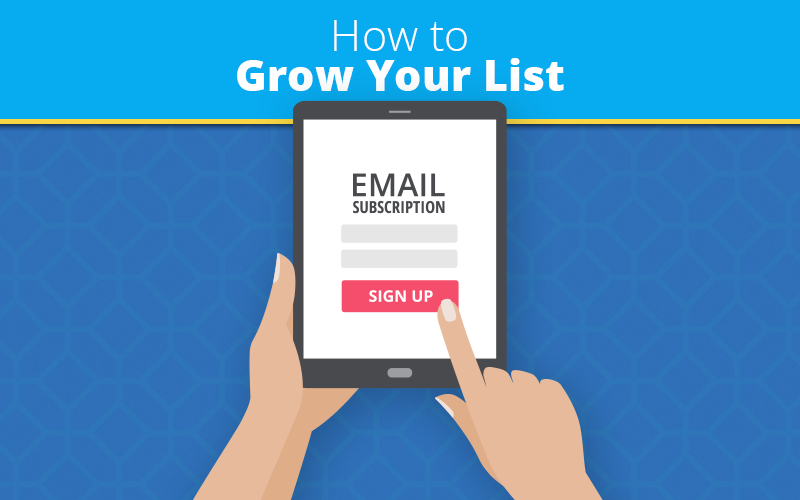No email list will prove as powerful or effective as the one you build in-house, made up of subscribers with whom you already have a working relationship. Here are 15 ways to begin building or increasing the size of your permission-based email list right now:
1. Put a sign-up form on your website that feeds right into your e-marketing platform and post a prominent link to it on your homepage. On the form, state clearly what your subscribers are signing up for. For example, “Sign up here to receive the latest news and tips from XYZ Organization, Inc.” Explain the benefits of joining your list, and state that you do not share email addresses with outside companies (and then don’t). Be sure to include a link to your privacy policy in the footer of your form.
At a minimum, collect email address and first name (for personalization). Keep it simple and don’t ask for more data than you need. Every data field that you add will increase the number of potential subscribers who abandon your form.
Online forms can be inline (form fields right on the web page itself), linked (link to form landing page) or pop-up (scheduled to pop up after a user is on the website for a specified amount of time or upon exit from your site).
2. Post an email sign-up form on your social networking pages. Create a Facebook button for your email sign-up form. Promote sign-ups on Twitter, Instagram and LinkedIn at least monthly.
3. Integrate an email sign-up form into your apps. Many companies and organizations miss this great opportunity to gather new sign-ups!
4. Incorporate a prominent sign-up link on your email templates. Have you ever had a friend forward you an email that you wanted to sign up for? Make it easy!
5. Have your customer service reps and/or receptionist ask all callers and visitors if they would like to be signed up to receive news or offers via email from your company or organization. Enter those new subscribers directly into your email platform and then be sure to send each new subscriber a message to confirm the subscription. (Hint: This can be automated.)
6. Run a digital marketing campaign to promote sign-ups. There is no doubt that paid digital marketing gets results, so if you have the budget for it, go for some paid search, social media or digital display advertising.
7. Place a link to your online sign-up form on every outgoing message from your organization. Invite business contacts, colleagues and customers to join your list every time you send an email. Most email apps allow individual users to create an email “signature” that is automatically appended to every outgoing email.
8. Generate a URL QR code for use in person, online or in print. Quick-response, or QR, codes are flexible and easy to use to gather email sign-ups. They can be posted online or in printed materials. Potential users simply scan the code with their smartphone cameras to link directly to your sign-up form.
9. Promote the benefits of signing up for your email program on printed marketing collateral, such as brochures, postcards and other mailings, sell sheets, catalogs, newsletters, advertisements, media/information kits, posters, etc. Include an easy-to-type shortened URL, such as ABCcompany.com/signup or a QR (quick-response) code.
10. Gather email sign-ups in person at your live events, such as trade shows, charity auctions, concerts and the like. Be sure to ask permission to send email news and offers. Many people are offended if they give you a business card and end up on your commercial email list. Having an iPad or laptop computer handy with the sign-up form on screen works well for in-person events. Another option is to display a quick-response code (QR code) that links to your sign-up form.
11. Set up a text-to-join program. This works best at live or televised events where you can encourage audience members to text a keyword to sign up for your email program. This also works at locations like restaurants or bars that have table tents on every table where you can promote the text-to-join opportunity.
12. Hold a subscription promotion online by raffling off a prize or two for new subscribers during the campaign. New subscribers love a chance to win sports event tickets, an autographed item or a gift certificate. This can be promoted on your social pages or your website or both.
13. For newsletter publishers: Promote subscriptions to your newsletter in another company or organization’s newsletter. For example, if you are a magazine publisher, you might consider promoting subscriptions to your publication in various book club e-newsletters. Some companies and organizations might be willing to “barter,” meaning you promote their newsletter and they promote yours at no cost to either party. This is a great way to reach an appropriate audience without renting an email list, which can be risky.
14. Sponsor the email newsletters/promotional emails of a complementary company or organization. As a sponsor, you should have the option to include your company logo on the email with a link to your homepage or online sign-up form. This is another great way to reach a broader audience without renting a list. (By the way, soliciting paid sponsorships can help pay for the costs associated with your own email campaigns.)
15. Ask complementary businesses and organizations to post a link to your homepage or sign-up form on their websites. As a courtesy, you might offer to create a reciprocal link on your own website.
A note about privacy: No matter which methods you use to gather email sign-ups, always explain to your subscribers what types of emails you will be sending, and state that you do not share email addresses with outside companies (and then don’t).
Good luck! You’re on your way to a growing, profitable house list!
If you need help putting together a list-growth strategy, contact the KCC team at to develop a custom plan for your business.

